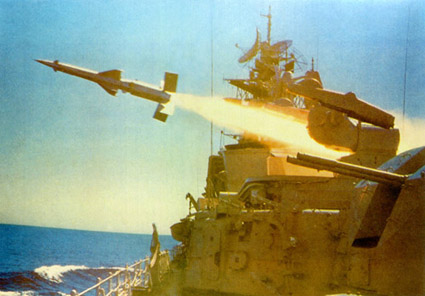فى بداية افكار تطوير منظومات sa-3 قامت شركة من بيلاروسيا اسمها
( تيترايدر- Tetraedr)
بانتاج حزمة الكترونية جديدة خاصة بتطويرات منظومة الدفاع الجوى الروسية
s-125 petchora او sa-3
المضادة للاشعاع الرادارى
بهدف تطوير اجرائات eccm فى المنظومة وكذلك كافة اجرائاتها الالكترونية , والدفاع ضد الصواريخ المضادة للاشعاع الرادارى
anti radiation missiles
او ما يطلق عليها اختصارا:
(arm)
وسميت تلك الحزمة الجديدة ب
srtz-2tm
srtz-2tm
و ذلك للدفاع ضد بطارية البيتشورا وراداراتها من الصواريخ المذكورة والتى تعتبر الد اعداء انظمة الدفاع الجوى , مما حدا بالجانب البيلاروسى لابتكار تلك الحزمة الالكترونية. وتطوير صواريخ sa-3 عموما .
وذلك لعدة اسباب تتعلق بالصاروخ نفسة.
1/ لمميزاتة العملية وقدراتة فى التتبع والتشابك.
2/ لتوافرة فى عدة دول ورغبة بعض تلك الدول فى تطويرة والاعتماد علية مستقبلا.
3/ لمديات الصاروخ نفسة وهى مديات معقولة والى حد كبير .
4/ تاريخ المنظومة المشرف فى كل الحروب التى خاضتها , وكان اخرها عملية عاصفة الصحراء, وحرب البلقان.
وهذا هو ما دفع بيلاروسيا ومن خلال الشركة المذكورة سابقا لتطوير تلك الصواريخ ومن بعدها روسيا
وترقية النسخة المذكورة من
s-125 sam system
الى
s-125 pechora 2m
وذلك لعدة اسباب تتعلق بالصاروخ نفسة.
1/ لمميزاتة العملية وقدراتة فى التتبع والتشابك.
2/ لتوافرة فى عدة دول ورغبة بعض تلك الدول فى تطويرة والاعتماد علية مستقبلا.
3/ لمديات الصاروخ نفسة وهى مديات معقولة والى حد كبير .
4/ تاريخ المنظومة المشرف فى كل الحروب التى خاضتها , وكان اخرها عملية عاصفة الصحراء, وحرب البلقان.
وهذا هو ما دفع بيلاروسيا ومن خلال الشركة المذكورة سابقا لتطوير تلك الصواريخ ومن بعدها روسيا
وترقية النسخة المذكورة من
s-125 sam system
الى
s-125 pechora 2m
وتدعيم الكترونياتها واجرائاتها الوقائية كما سبق.
وتكون تلك الحزمة الجديدة مرتبطة برادار الاشتباك للمنظومة من نوع
وتكون تلك الحزمة الجديدة مرتبطة برادار الاشتباك للمنظومة من نوع
SNR-125-2TM engagement radar
وبالتالى اصبحت المنظومة قادرة على التغلب على كل الصواريخ المضادة للاشعاع الرادارى
ومنها:
1/ صواريخ ( دليلة ) الاسرائيلية المضادة للاشعاع الرادارى.

2/ صواريخ الهارم...AGM-88A/B/C HARM

3/ الفرنسى as.37 martel.

4/ البريطانى alarm.

5/ ايضا كل الصواريخ المضادة للاشعاع الرادارى من فئة الصاروخ الامريكى..AGM-137 Tacit Rainbow.

وبالتالى اصبحت المنظومة قادرة على التغلب على كل الصواريخ المضادة للاشعاع الرادارى
ومنها:
1/ صواريخ ( دليلة ) الاسرائيلية المضادة للاشعاع الرادارى.

2/ صواريخ الهارم...AGM-88A/B/C HARM

3/ الفرنسى as.37 martel.

4/ البريطانى alarm.

5/ ايضا كل الصواريخ المضادة للاشعاع الرادارى من فئة الصاروخ الامريكى..AGM-137 Tacit Rainbow.

وظيفة تلك الحزمة الالكترونية الجديدة srtz-2tm هى :
التغلب على
1/ جميع المقذوفات المضادة للاشعاع الرادارى ..والعاملة بنظام توجية GPS او GLOPAL POSITIONING SYSTEM.
2/ وهى التغلب على تلك المقذوفات ذات بواحث موجية ملليمترية
MilliMetric Wave Imaging (MMWI) seekers
كتلك المستخدمة فى بعض قنابل jdam وصواريخ المافريك.
3/ قدرات للتعامل مع المقذوفات الموجهة بصريا او حراريا .. eo/ir.
التغلب على
1/ جميع المقذوفات المضادة للاشعاع الرادارى ..والعاملة بنظام توجية GPS او GLOPAL POSITIONING SYSTEM.
2/ وهى التغلب على تلك المقذوفات ذات بواحث موجية ملليمترية
MilliMetric Wave Imaging (MMWI) seekers
كتلك المستخدمة فى بعض قنابل jdam وصواريخ المافريك.
3/ قدرات للتعامل مع المقذوفات الموجهة بصريا او حراريا .. eo/ir.
من هذا المنطلق اصبح للمنظومة الصاروخية القدرة على
التغلب على الصواريخ ARM ( او ما يشار لة ب KILL PROBABILITY- Pk) بالنسب المئوية الاتية:
95% لاول قصف من صواريخ الهارم... كحالة قياسية.
93% للقصفة الثانية
90% للقصفة الرابعة.
اما الحزمة الالكترونية ذاتها srtz-2tm فاصبح لها قدرة بقائية
93% / 92% / 90%, على التوالى.
وعلى عكس اجهزة التشويش الاخرى المستخدمة فى الدفاعات الجوية
ف srtz-2tm يتميز بالحركية نظرا لتحميلة على عربة MAZ-6317 6 x 6
ومولد ذو قدرة 20 كيلو وات, لتغذية المنظومة بالطاقة الكهربائية.
التغلب على الصواريخ ARM ( او ما يشار لة ب KILL PROBABILITY- Pk) بالنسب المئوية الاتية:
95% لاول قصف من صواريخ الهارم... كحالة قياسية.
93% للقصفة الثانية
90% للقصفة الرابعة.
اما الحزمة الالكترونية ذاتها srtz-2tm فاصبح لها قدرة بقائية
93% / 92% / 90%, على التوالى.
وعلى عكس اجهزة التشويش الاخرى المستخدمة فى الدفاعات الجوية
ف srtz-2tm يتميز بالحركية نظرا لتحميلة على عربة MAZ-6317 6 x 6
ومولد ذو قدرة 20 كيلو وات, لتغذية المنظومة بالطاقة الكهربائية.
وخمسة دقائق فقط هو الفارق الزمنى بين القصف من
المنظومة وتغيير المواقع او ما يطلق علية ....
shoot-and-scoot.
ويعتبر تصميم الحزمة متميز نظرا لكونة يعتمد على زوج من الهوائيات , كلا منهم بقنوات تغذية مضغوطة للدليل الموجى, احدهم يتم وضعة على سطح الشاحنة, والثانى يتم وضعة على ذراع صغير طولة 5 متر.
هذا بالاضافة الى وحدة تحكم مع الهوائيين المذكورين لبث الترددات عبرهما , اما الجهاز الخاص بالتشويش فى الحزمة المذكورة فهو يعمل على بث هدف خاطئ للطائرات المعادية, حيث يقوم بتلقى الترددات المنيعثة من الرادار الاصلى من خلال قناة اتصال مستقلة تقوم على اثرها المنظومة بتوليف موجات خادعة
واكثر جاذبية للصاروخ المضاد للرادار عن رادار منظومة الصاروخ الاصلي.
ومعدل تغطية هوائيى الحزمة 360 درجة , وتغطية الارتفاع ما بين 15 درجة و 80 درجة.
ولم توضح شركة ( تيترايدر) ( tetraedr) اكثر من ذلك.
* * *
المنظومة وتغيير المواقع او ما يطلق علية ....
shoot-and-scoot.
ويعتبر تصميم الحزمة متميز نظرا لكونة يعتمد على زوج من الهوائيات , كلا منهم بقنوات تغذية مضغوطة للدليل الموجى, احدهم يتم وضعة على سطح الشاحنة, والثانى يتم وضعة على ذراع صغير طولة 5 متر.
هذا بالاضافة الى وحدة تحكم مع الهوائيين المذكورين لبث الترددات عبرهما , اما الجهاز الخاص بالتشويش فى الحزمة المذكورة فهو يعمل على بث هدف خاطئ للطائرات المعادية, حيث يقوم بتلقى الترددات المنيعثة من الرادار الاصلى من خلال قناة اتصال مستقلة تقوم على اثرها المنظومة بتوليف موجات خادعة
واكثر جاذبية للصاروخ المضاد للرادار عن رادار منظومة الصاروخ الاصلي.
ومعدل تغطية هوائيى الحزمة 360 درجة , وتغطية الارتفاع ما بين 15 درجة و 80 درجة.
ولم توضح شركة ( تيترايدر) ( tetraedr) اكثر من ذلك.
* * *
التطوير الروسى / البيلاروسى.
فقد جاء هذا التطوير من خلال شركة روسية / بيلاروسية
اسمها ( الانظمة الدفاعية الروسية-البيلاروسية ) Oboronitelnye Sistemy.
وهو انتاج جهاز بث خداعى لتطويراتهم من منظومة s-125 m mobile sa-3 goa systems
وبالفعل تم انتاج منظومة جديدة وسميت ب
اسمها ( الانظمة الدفاعية الروسية-البيلاروسية ) Oboronitelnye Sistemy.
وهو انتاج جهاز بث خداعى لتطويراتهم من منظومة s-125 m mobile sa-3 goa systems
وبالفعل تم انتاج منظومة جديدة وسميت ب
( KRTZ-125-2M)
وذلك بهدف حماية UNV-1 Low Blow engagement radar
او رادار التعقب والاشتباك فى منظومة السام 3 وهو ( لو بلو).من هجمات صواريخ
anti radiation missiles.
وتلك هى صورتة:

ويمكن استخدام ذلك الشرك الخداعى فى النسخ السوفيتية المختلفة ايضا من الصواريخ ارض/ جو.
1/ وحدة التحكم الرئيسية واسمها (OI-125BS )
والتى تباشر عملها من خلال وصلة راديو ومرتبطة بست وحدات بث رادارى من OI-125BS
والتى عادة ما يتم وضعها فى اطار دائرة قطرها 300 متر.
2/ وحدة التحكم المسماة OI-125BS مزودة بكابل او وصلة راديو مرتبطة برادار المنظومة الاصلى وهو ( لو بلو ) .... وصورتة بالاعلى.
3/ جهاز UV-74 للتحكم فى اطلاق الصواريخ بشكل متزامن .
4/ كاميرا تعمل بالاشعة فوق البنفسجية UV-82.
5/ وحدة اختبارية.
6/ قطع غيار للمنظومة الالكترونية ومولد للطاقة الكهربائية وشاحن .
7/ سيارة من طراز Ural-4320 6 x 6 truck
لحمل كل هذا العتاد وتلك صورتها:

واخيرا فان هذة الحزمة الروسية البيلاروسية توفر معدل Pk بقاء لمنظومة السام 3 من صواريخ arm بنسبة:
90% للقصف الاول
80% للقصف الثانى.
مما سبق يتضح بالفعل ان هناك امكانيات كبيرة للبيتشورا فى التعامل مع الصواريخ المضادة للرادار وهو رعب منظومات الدفاع الجوى القديمة.
تحياتى.
وتلك صورة لها:


وذلك بهدف حماية UNV-1 Low Blow engagement radar
او رادار التعقب والاشتباك فى منظومة السام 3 وهو ( لو بلو).من هجمات صواريخ
anti radiation missiles.
وتلك هى صورتة:

ويمكن استخدام ذلك الشرك الخداعى فى النسخ السوفيتية المختلفة ايضا من الصواريخ ارض/ جو.
ويتكون النظام من الاتى:
1/ وحدة التحكم الرئيسية واسمها (OI-125BS )
والتى تباشر عملها من خلال وصلة راديو ومرتبطة بست وحدات بث رادارى من OI-125BS
والتى عادة ما يتم وضعها فى اطار دائرة قطرها 300 متر.
2/ وحدة التحكم المسماة OI-125BS مزودة بكابل او وصلة راديو مرتبطة برادار المنظومة الاصلى وهو ( لو بلو ) .... وصورتة بالاعلى.
3/ جهاز UV-74 للتحكم فى اطلاق الصواريخ بشكل متزامن .
4/ كاميرا تعمل بالاشعة فوق البنفسجية UV-82.
5/ وحدة اختبارية.
6/ قطع غيار للمنظومة الالكترونية ومولد للطاقة الكهربائية وشاحن .
7/ سيارة من طراز Ural-4320 6 x 6 truck
لحمل كل هذا العتاد وتلك صورتها:

واخيرا فان هذة الحزمة الروسية البيلاروسية توفر معدل Pk بقاء لمنظومة السام 3 من صواريخ arm بنسبة:
90% للقصف الاول
80% للقصف الثانى.
مما سبق يتضح بالفعل ان هناك امكانيات كبيرة للبيتشورا فى التعامل مع الصواريخ المضادة للرادار وهو رعب منظومات الدفاع الجوى القديمة.
تحياتى.
التعديل الأخير:



